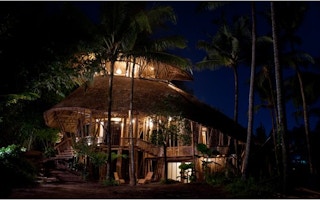When Macarena Chiriboga came to Bali in 2009, she had just finished a master’s degree in architecture in the United States, doing her thesis on the use of bamboo as a building material.
The trip was meant to be a vacation. But drawn by the unusual architecture of a school on the island — the Green School, whose buildings are all made from bamboo — she was soon back, and is now designing buildings for a “green village” being built by the developer Ibuku International about an hour’s drive from the Indonesian island’s beaches.
With Effan Adhiwira, a 28-year-old Indonesian who is senior architect and also oversees construction at Green School, the Ibuku team is creating a collection of structures that look more like treehouses and pirate ships than luxury villas.
But they are actually luxury villas. Perched on huge bamboo poles, and overshadowed by lush green jungle on the edge of the rock-strewn Ayung River, they have multiple, verandah-like levels, beautifully designed kitchens and bathrooms, and very few walls.
“People tend to have this assumption that luxury is all about air-conditioning and technology, about owning a big car — but luxury can also be about feeling the wind blow right through your house, being in contact with nature and walking around barefoot in your home,” said Ms. Chiriboga, 26. “These houses are all about allowing people to realize their dream of sustainable living, of experiencing a whole different lifestyle.”
Three dozen buildings will ultimately form the “Green Village,” which is going up on three hectares, or almost 7.5 acres, of land. One has been completed, and its owner is moving in next week. A second is expected to be finished in a few weeks and several more in the next few months. Five homes have been sold already and the sales of at least four more are being negotiated.
Each one boggles the mind, pleasantly, doing things with bamboo that you would never think bamboo could do.
Giant, 18-meter, or 59-foot, poles, each about 25 centimeters, or nearly a foot, wide, support the roofs and several layers of open-plan floors. Some jut out, mast-like, at odd angles. Smaller, slimmer poles form open-sided stairs that lead from one platform-like level to the next — three or four in each house.
The flooring, the roofs, the banisters that fence in the terrace-like living spaces, but leave the sides open — everything is made of bamboo, lightweight, bendable, super-tensile and specially treated to protect it from the ravages of insects and humidity.
There’s hardly a right angle in sight. Curves and gentle bends rule. “We’re taking bamboo to a different level,” said Ms. Chiriboga, who is from Ecuador. “Where I come from, in South America, bamboo is seen as a poor man’s material. If you’re rich, you won’t use it to build a house. When I show people pictures of what we’re doing here, they are amazed. They never thought you could do these things with bamboo.”
Each of the houses is unique, fitted around the plot on which it is built, said Elora Hardy, creative director at Ibuku. There was no need to bulldoze the jungle, dig foundations and build retaining walls: The structures simply rest on poles anchored in the rock, contouring around their part of the steep river bank.
Each is to some extent tailored to the buyer’s special wishes: Want an open-plan office-cum-media room? Or two rather than three bedrooms? An extra guest bathroom? But, of course.
“It’s like building a super yacht, made to measure, in the middle of the jungle,” said Peter Wrathall, commercial director at Ibuku. At a cost of $225,000 to $750,000 each, the buildings are drawing interest from around the world, he said.
Indonesia as a whole, and Bali in particular, has become increasingly popular with foreign investors, drawn by the country’s friendly climate and buoyant economy. Foreigners cannot own land or houses directly in their own name in the country but it is possible, and common, for them to arrange ownership through local nominees or surrogates. Another option is to acquire long-term leases of as long as 25 years, which can be transferable and extendable, and are thus an attractive alternative, Mr. Wrathall said.
Possibly the most unusual aspect of the Ibuku houses — apart from the fact that they are 98 percent bamboo — is that their sides are largely open to the elements.
Beneath the canopy-like roofs, which are in turn overshadowed by the jungle, there are only floors and the bamboo support pillars. The houses have 150 to 300 square meters, or 1,615 to 3,230 square feet, of living space, but no walls, no windows.
That may sound unbearably hot and steamy, but there generally is a gentle breeze blowing through the structures.
Buyers can opt to have parts of their houses enclosed — with bamboo walls — so the areas can be cooled and dehumidified. But most areas are free of energy-guzzling air-conditioning and costly insulation materials. Ibuku also plans to take the whole “village” off Bali’s electric grid, providing power from biomass, the energy given off by decaying natural materials — all in line with the green, environmentalist philosophy that pervades the development.

















